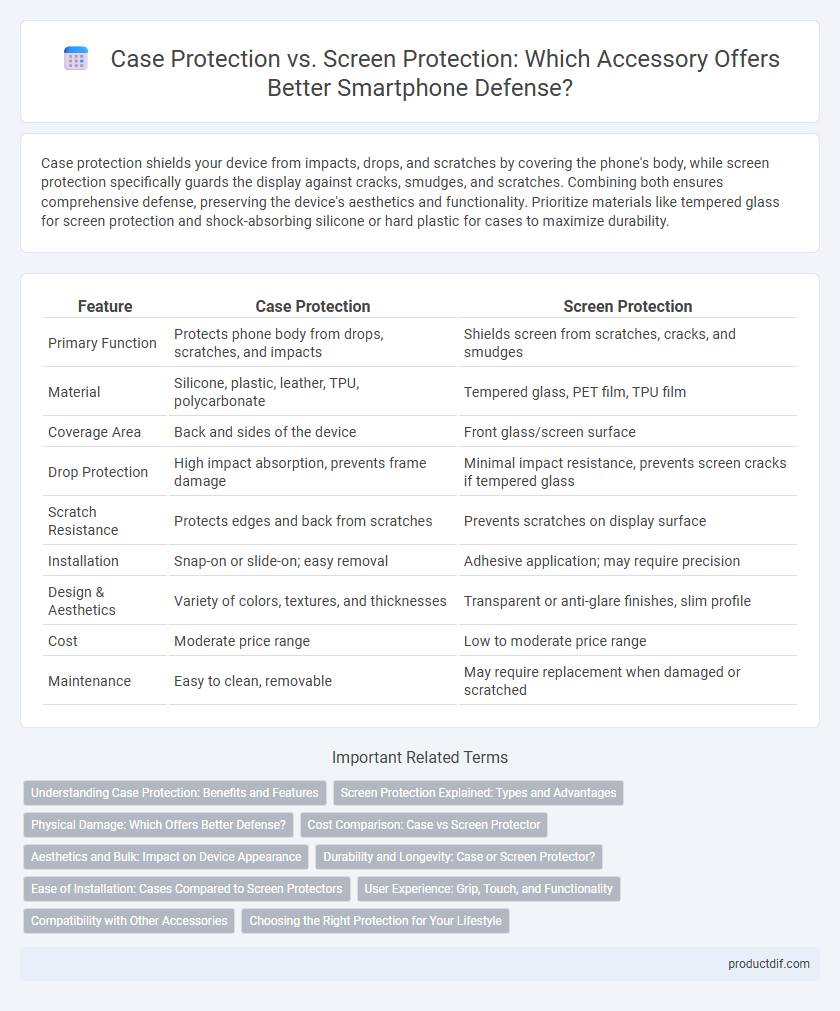Case protection shields your device from impacts, drops, and scratches by covering the phone's body, while screen protection specifically guards the display against cracks, smudges, and scratches. Combining both ensures comprehensive defense, preserving the device's aesthetics and functionality. Prioritize materials like tempered glass for screen protection and shock-absorbing silicone or hard plastic for cases to maximize durability.
Table of Comparison
| Feature | Case Protection | Screen Protection |
|---|---|---|
| Primary Function | Protects phone body from drops, scratches, and impacts | Shields screen from scratches, cracks, and smudges |
| Material | Silicone, plastic, leather, TPU, polycarbonate | Tempered glass, PET film, TPU film |
| Coverage Area | Back and sides of the device | Front glass/screen surface |
| Drop Protection | High impact absorption, prevents frame damage | Minimal impact resistance, prevents screen cracks if tempered glass |
| Scratch Resistance | Protects edges and back from scratches | Prevents scratches on display surface |
| Installation | Snap-on or slide-on; easy removal | Adhesive application; may require precision |
| Design & Aesthetics | Variety of colors, textures, and thicknesses | Transparent or anti-glare finishes, slim profile |
| Cost | Moderate price range | Low to moderate price range |
| Maintenance | Easy to clean, removable | May require replacement when damaged or scratched |
Understanding Case Protection: Benefits and Features
Case protection offers robust defense against drops, impacts, and scratches by enveloping the phone's edges and back with durable materials like TPU, polycarbonate, or leather. It enhances grip and prevents damage to vulnerable areas while often including raised bezels to safeguard the screen without obstructing touch sensitivity. Unlike screen protectors that shield only the display, cases provide comprehensive protection, maintaining the device's structural integrity during everyday use.
Screen Protection Explained: Types and Advantages
Screen protection primarily involves tempered glass and plastic film options, each designed to prevent scratches, cracks, and smudges on device displays. Tempered glass offers high durability and clarity with superior touch sensitivity, while plastic films provide lightweight, flexible protection with anti-glare and privacy features. These screen protectors enhance device longevity and resale value by maintaining screen integrity against daily wear and accidental damage.
Physical Damage: Which Offers Better Defense?
Case protection provides comprehensive defense against drops, impacts, and scratches by absorbing shock and covering the device's edges and back. Screen protection, such as tempered glass or plastic films, specifically guards against scratches, cracks, and shattering of the display surface. For optimal physical damage prevention, combining both case and screen protectors delivers the most effective defense for smartphones and tablets.
Cost Comparison: Case vs Screen Protector
Cases generally cost between $10 and $50, offering comprehensive protection against drops, scratches, and impacts by covering the device's back and sides. Screen protectors typically range from $5 to $30, providing a thin layer of defense against scratches and minor cracks on the display surface. Investing in a case often delivers broader protection for the smartphone, while screen protectors offer targeted defense for the display at a lower initial cost.
Aesthetics and Bulk: Impact on Device Appearance
Case protection offers a sturdy shield that often adds noticeable bulk, altering the sleek design and original aesthetics of the device. Screen protection, such as tempered glass or film, maintains the device's slim profile and transparency, preserving the visual clarity and touch sensitivity of the display. Balancing between case bulkiness and screen clarity is essential for users seeking both device safety and an unobstructed appearance.
Durability and Longevity: Case or Screen Protector?
Case protection offers comprehensive durability by shielding the device's body from drops, impacts, and scratches, prolonging its overall lifespan. Screen protectors specifically safeguard the display from scratches and cracks but provide limited defense against severe drops or side impacts. For optimal longevity, combining both case protection and a high-quality screen protector ensures maximum durability and extended device life.
Ease of Installation: Cases Compared to Screen Protectors
Cases generally offer easier installation than screen protectors, requiring a simple snap-on or slide-in process without the need for precise alignment. Screen protectors demand careful positioning and bubble-free application, often needing tools like dust removers or squeegees. The hassle-free installation of phone cases makes them a preferred choice for users seeking convenient and immediate protection.
User Experience: Grip, Touch, and Functionality
Case protection enhances grip and drop resistance by adding textured surfaces, improving overall handling without compromising device size. Screen protection preserves touch sensitivity and clarity, ensuring smooth interactions while guarding against scratches and cracks. Balancing both accessories optimizes user experience, maintaining device functionality and aesthetic appeal.
Compatibility with Other Accessories
Case protection offers robust compatibility with other accessories such as phone grips, mounts, and wireless chargers, designed to securely fit around the device without obstructing functionality. Screen protection films and tempered glass maintain touch sensitivity and clarity, allowing seamless use of styluses and edge-to-edge display accessories. Choosing accessories that complement each other ensures full device functionality without compromising protection or user experience.
Choosing the Right Protection for Your Lifestyle
Selecting the right case protection versus screen protection depends on lifestyle factors such as activity level and environment. A rugged case offers comprehensive shock absorption for high-impact activities or outdoor use, while tempered glass screen protectors guard against scratches and cracks during everyday handling. Combining both ensures maximum device durability tailored to individual usage patterns.
Case protection vs screen protection Infographic

 productdif.com
productdif.com